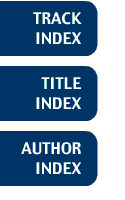
Track: Ecology, Conservation, and Archaeology
SIGBMA: A Spatial Information System for Determining Natural or Anthropic Modifications on Life Zones

Leyla Jael Garcia-CastroGerman E. Bravo-Cordoba
SIGBMA is a spatial information system designed to support the decision making process concerning the conservation of life zones in natural parks and protected areas. This objective is achieved by (1) the visualization of all the life zones present in the area, (2) the use of qualitative theoretic models to determine the theoretical life zones, and (3) the assessment of modified zones and the phenomena describing the change. The various coverages used in SIGBMA are ú Basic Information: It corresponds to informative coverages, with nonrelevant information to the considered problem. Some examples are the hydrography, roads, and control posts. ú Spanning Coverages: These are coverages with basic information used to determine the life zones in the area. These coverages are the altitude (DEM) and the climatic variables such as humidity, rain level, and wind. ú Vegetation Coverages, which can be classified as ú Real Coverages: Issued from remote sensing information or digitalization and the use of aerial photography. ú Theoretical Coverages: These coverages are generated by applying a qualitative theoretical model to the spanning coverages. The models may include one or more spanning coverages, in which case there exists a decision model in order to determine the resultant life zone. ú Change Coverages: They are generated by the overlay of two real or theoretical coverages. They are used to assess the modified life zones and their corresponding phenomena. The visualization of these life zones, their changes, and the assessment of the occurred phenomena help the head of the park to identify the main affected areas and the main modifications in the park. Based on this information, the head of the park can take action and define policies to preserve the life zones. SIGBMA was developed in ArcInfo and ArcView GIS, using AML and Avenue as programming languages. In addition, its structure and functionalities were formally specified using the specification language Z.
Leyla Jael Garcia-Castro
Universidad de los Andes
Calle 19 A # 1-18 Este
Santafe de Bogota, D.C., 1
COLOMBIA
Telephone: 571- 2 86 61 85
Fax: 571 - 2 84 07 96
E-mail: l-garcia@uniandes.edu.co